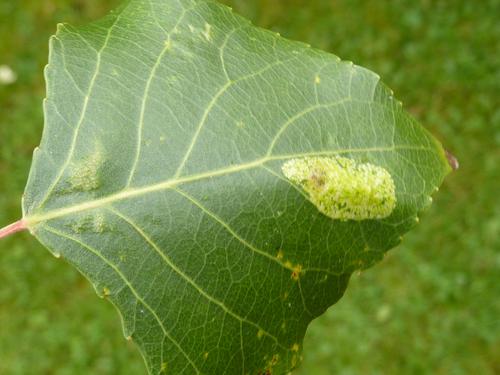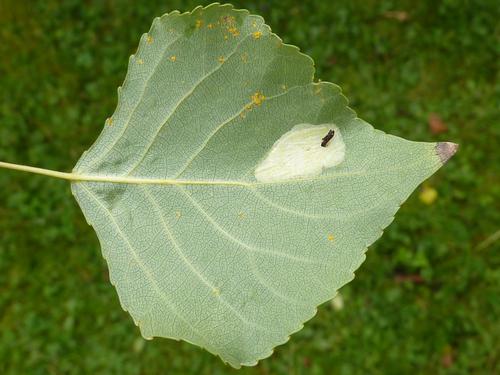Phyllonorycter comparella (Duponchel) rediscovered in Worcestershire
Tony Simpson
This small leaf-mining moth (Lepidoptera: Gracillariidae) was recorded first in Worcestershire by J.E. Fletcher in 1873. There are two specimens in the Worcester Museum collection labelled “Worcs. Ex Populus nigra “ dated 16/8/1873 & 20/8/1873 which probably came from Worcester City or its environs as he seems to have done most of his collecting in or just outside the city.
The moth is very local in the U.K. and the larva is usually recorded as making an inflated blotch mine in the leaves of Grey Poplar (Populus x canescens) and in the literature it seemed uncertain as to whether it fed in other Poplars. The larva feeds in July and September and the second generation then overwinters as hibernating imagines.
In 1976 I found similar mines in Aspen (Populus tremula) in the Drakes Broughton area and bred out moths which turned out to be Phyllonorycter sagitella (Bjerkander) previously known at that time in the U.K. only from Gloucestershire (Price, L., 1977. Entomologist’s Rec. J. Var. 89: 107-107). I also noticed however on examining the Worcester Museum collection that there were four specimens of sagitella also collected by Fletcher labelled “Worcester ex Populus tremula “ three dated 4/8/1876 and one dated 6/8/1876.
In 1976 I was just getting interested in the Microlepidoptera and I found what appeared to be five Phyllonorycter mines in a old Populus nigra by the Laugherne Brook in St. Johns, Worcester in July but failed to breed out any moths. I often searched this and adjacent Poplars in the intervening years but never found any more!
Then this year Oliver Wadsworth Emailed me with an image of a Phyllonorycter mine in a hybrid Black Poplar from just outside Worcester at Powick Bridge near the River Teme. We went there together on 24th September 2010 and found 12 mines, some already vacated, on three small hybrid Black Poplars just north of Powick Bridge. I thought we ought to look at the locality in St. Johns where I had seen the mines in 1976, and there we found five mines on the original Black Poplar and on a hybrid Black Poplar close by in a Pub car park on the other side of the road. Later on 25th September 2010 I found a vacated mine on a hybrid Black poplar at Diglis, Worcester on the east bank of the Severn, and three mines on a Lombardy Poplar by the old town bridge in the centre of Worcester City.
I mentioned these finds to Michael Harper and he thought we ought to look for it at Castlemorton Common in South Worcestershire which is well known for it large numbers of old pollarded Black Poplars P. nigra. We went together on 28th September 2010 and found about 30 mines in a very localised area on the common, some in a Grey Poplar and in its surrounding root suckers, and some on the pollard Black Poplars nearby. Further afield we could not find it however on Nettlebed Common or on Chase End Hill across the border in Herefordshire.
I asked Robert Homan if he was seeing any in adjacent parts of Gloucestershire but he has so far not found any but did find a vacated mine in a White Poplar Populus alba on the outskirts of Upton upon Severn in Worcestershire. I looked there on hybrid and Lombardy Poplars by the river without success and I have also failed to find any on various Poplars at Stourport, Pershore, Malvern, and near Evesham.
Phyllonorycter comparella is obviously having a good year , at least locally, and the fact that it now seems to be utilising a number of different species of poplar seems unusual given its apparent confinement to Grey Poplar elsewhere in the U.K. in recent years. I wonder if it may have made a “jump” to becoming a more generalised poplar feeder, as seems to have happened with the micromoth Phyllonistis saligna (Zeller) on Salix species. This moth was a specialist on Purple Willow(Salix purpurea )and although there was a Victoria County History record for Worcester and some specimens in Worcester Museum I could not find any here in the 1970s-1990s and it was a localised U.K. moth. Then Robert Homan (that man again!) found it was present in rapidly increasing numbers near Tewksbury and then into Worcestershire in 2004. It has since spread throughout the county in large numbers feeding on the long leaved Willow species Salix fragilis, S. alba, S. babylonica , and their hybrids as well as S. purpurea (which is uncommon locally) except osier (S. viminalis).
It could be we are seeing a similar change in the behaviour of P. comparella, in which case it may become much more common and widespread over the next few years?
Reference
PRICE, L. 1977. Phyllonorycter sagitella (Bjerkander, 1790) = tremulae Zeller, 1846 (Lep., Gracillariidae). A species new to Britain. Entomologist’s Record and Journal of Variation. 89:106-107.

